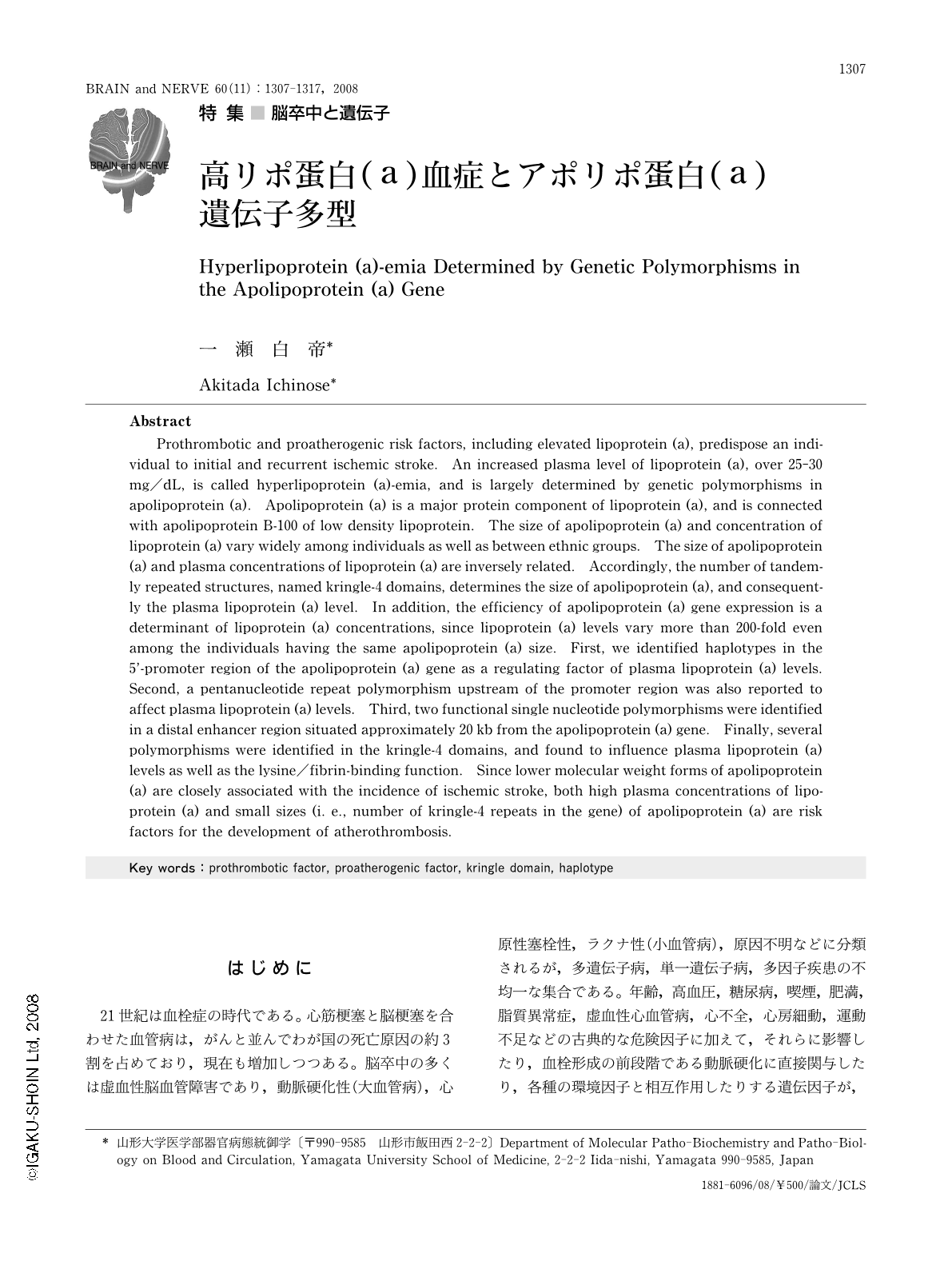Japanese
English
- 有料閲覧
- Abstract 文献概要
- 1ページ目 Look Inside
- 参考文献 Reference
はじめに
21世紀は血栓症の時代である。心筋梗塞と脳梗塞を合わせた血管病は,がんと並んでわが国の死亡原因の約3割を占めており,現在も増加しつつある。脳卒中の多くは虚血性脳血管障害であり,動脈硬化性(大血管病),心原性塞栓性,ラクナ性(小血管病),原因不明などに分類されるが,多遺伝子病,単一遺伝子病,多因子疾患の不均一な集合である。年齢,高血圧,糖尿病,喫煙,肥満,脂質異常症,虚血性心血管病,心不全,心房細動,運動不足などの古典的な危険因子に加えて,それらに影響したり,血栓形成の前段階である動脈硬化に直接関与したり,各種の環境因子と相互作用したりする遺伝因子が,脳梗塞の危険因子として重要である。特に,炎症,血液凝固や血管壁の成分の異常,代謝の障害を起きやすくするような遺伝子変異や多型性は,発症頻度の高さ,発症年齢の若さと相関している。これらのうち,向血栓性あるいは血栓傾向は,凝固系,線溶系,血小板,血管内皮細胞の変調をきたす遺伝子変異や多型性によって惹起される(文献1の表1,2を参照)。
まず,凝固系では凝固V因子Leiden変異(Arg506Gln),プロトロンビン遺伝子3'領域多型(G20210A),フィブリノーゲンβ鎖遺伝子5'発現調節領域多型(G-455A),XIII因子Val34Leu多型などが脳梗塞の危険因子であるが,β鎖G-455A以外は日本人を含むモンゴロイドには存在しない。抗凝固系では,アンチトロンビン,プロテインC,Sの欠損や多型,トロンボモジュリンAla455Val多型,血小板では糖蛋白質GPIbαのMet145Thr多型,GPIIIaのLeu33Pro多型などが血栓症と相関することが知られている。線溶系ではプラスミノゲンアクチベーターインヒビタータイプ1遺伝子の5'発現調節領域の縦列繰り返し配列多型(4G/5G-675)と,アポリポプロテイン(a)[以後,アポ(a)]遺伝子のクリングルドメインの数とアミノ酸配列,5'発現調節領域の多型が,それぞれの遺伝子産物を増加させる重要な危険因子である。本稿では,後者のアポ(a)遺伝子と脳梗塞の関係について述べる。
Abstract
Prothrombotic and proatherogenic risk factors,including elevated lipoprotein (a),predispose an individual to initial and recurrent ischemic stroke. An increased plasma level of lipoprotein (a),over 25-30 mg/dL,is called hyperlipoprotein (a)-emia,and is largely determined by genetic polymorphisms in apolipoprotein (a). Apolipoprotein (a) is a major protein component of lipoprotein (a),and is connected with apolipoprotein B-100 of low density lipoprotein. The size of apolipoprotein (a) and concentration of lipoprotein (a) vary widely among individuals as well as between ethnic groups. The size of apolipoprotein (a) and plasma concentrations of lipoprotein (a) are inversely related. Accordingly,the number of tandemly repeated structures,named kringle-4 domains,determines the size of apolipoprotein (a),and consequently the plasma lipoprotein (a) level. In addition,the efficiency of apolipoprotein (a) gene expression is a determinant of lipoprotein (a) concentrations,since lipoprotein (a) levels vary more than 200-fold even among the individuals having the same apolipoprotein (a) size. First,we identified haplotypes in the 5'-promoter region of the apolipoprotein (a) gene as a regulating factor of plasma lipoprotein (a) levels. Second,a pentanucleotide repeat polymorphism upstream of the promoter region was also reported to affect plasma lipoprotein (a) levels. Third,two functional single nucleotide polymorphisms were identified in a distal enhancer region situated approximately 20 kb from the apolipoprotein (a) gene. Finally,several polymorphisms were identified in the kringle-4 domains,and found to influence plasma lipoprotein (a) levels as well as the lysine/fibrin-binding function. Since lower molecular weight forms of apolipoprotein (a) are closely associated with the incidence of ischemic stroke,both high plasma concentrations of lipoprotein (a) and small sizes (i. e.,number of kringle-4 repeats in the gene) of apolipoprotein (a) are risk factors for the development of atherothrombosis.

Copyright © 2008, Igaku-Shoin Ltd. All rights reserved.


